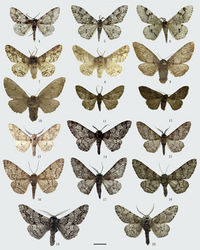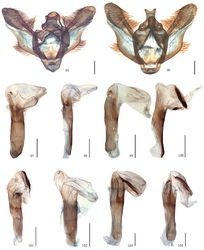Biston melacron
| Notice: | This page is derived from the original publication listed below, whose author(s) should always be credited. Further contributors may edit and improve the content of this page and, consequently, need to be credited as well (see page history). Any assessment of factual correctness requires a careful review of the original article as well as of subsequent contributions.
If you are uncertain whether your planned contribution is correct or not, we suggest that you use the associated discussion page instead of editing the page directly. This page should be cited as follows (rationale):
Citation formats to copy and paste
BibTeX: @article{Jiang2011ZooKeys139, RIS/ Endnote: TY - JOUR Wikipedia/ Citizendium: <ref name="Jiang2011ZooKeys139">{{Citation See also the citation download page at the journal. |
Ordo: Lepidoptera
Familia: Geometridae
Genus: Biston
Name
Biston melacron Wehrli, 1941 – Wikispecies link – Pensoft Profile
- Biston melacron Wehrli, 1941[1], in Seitz, Gross-Schmett. Erde, 4 (Suppl.): 430, pl. 35: h. Syntypes 3♂, China: West Tien-Mu-shan, 1600 m. (ZFMK)
- Biston exotica Inoue, 1977[2], Bull. Fac. domestic Sci., Otsuma Woman‘s Univ., 13: 322, figs 65–67. Holotype ♂, Japan: Kochi Prefecture, Kubokawa. (BMNH) (Synonymized by Heppner and Inoue (1992)[3])
Diagnosis
The external characters of this species are close to those of Biston marginata as follows: the male antennae are partially bipectinate and filiform at tip; the forewing postmedial line bilobedly protrudes between M1 and M3, and slightly protrudes outwards between CuA2 and 1A + 2A. But it can be distinguished from Biston marginata by the following characters: the hindwing outer margin is concave between M1 and M3, whereas it is evenly round in Biston marginata; the transverse lines are black but dark brown in Biston marginata; the hindwing postmedial line is waved after M3, but straight in Biston marginata; the transverse lines on the underside of the wings are more conspicuous. The most distinct differences are in the male genitalia: the apex of the uncus is broader and bifurcated, whereas it is narrower and round in Biston marginata; the median process of the gnathos is broader and round terminally, while in Biston marginata, it is slenderer and acute apically; the setose area of the valva is much weaker; the juxta is narrower, and sharply pointed apically, while in Biston marginata, it is broader and round apically; the cornutus is shortly digitiform, but is thornlike in Biston marginata. In the female genitalia (Inoue 1977[2]), the signum is much longer than in Biston marginata.
Material examineds
CHINA, Chekiang [Zhejiang] (ZFMK): West Tien-Mu-shan, 1600 m, 27–29.IV.1932, coll. H. Höne, 3♂ (Syntypes); same data, 25.IV.1932, 1♂; same data, 25.V.1932, 1♂; same locality, 400 m, IV.1936, 1♂. Fukien [Fujian] (ZFMK):Kuatun, 2300 m, 3–7.IV.1938, 11.IV.1946, coll. J. Klapperich, 1♂. Formosa [Taiwan] (ZFMK): Puli, IV.1958, coll. ZSM, 1♂. Sichuan (IZCAS): Mt. Emei, Qingyinge, 800–1000 m, 17.IV–1.V.1957, coll. Zhu Fuxing & Huang Keren, 8♂.
Distribution
China (Zhejiang, Jiangxi, Fujian, Taiwan, Sichuan), Japan, South Korea.
Taxon Treatment
- Jiang, N; Xue, D; Han, H; 2011: A review of Biston Leach, 1815 (Lepidoptera, Geometridae, Ennominae) from China, with description of one new species ZooKeys, 139: 45-96. doi
Other References
- ↑ Wehrli E (1938–1954) Subfamilie: Geometrinae. In: Seitz A (Ed) Die Grossschmetterlinge der Erde. Vol. 4 (Supplement), Verlag A. Kernen, Stuttgart, 254–766, taf. 19–53.
- ↑ 2.0 2.1 Inoue H (1977) Catalogue of the Geometridae of Japan (Lepidoptera). Bulletin of Faculty of Domestic Sciences, Otsuma Women’s University 13: 227-346.
- ↑ Heppner J, Inoue H (1992) Lepidoptera of Taiwan. Vol. 1, Part 2: checklist, Gainesville, Florida, 276 pp.
Images
|


